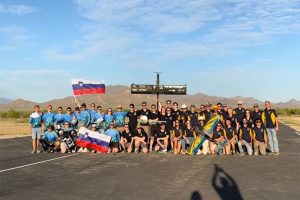The team, consisting of students from the Faculty of Mechanical Engineering, one student from the Biotechnical Faculty and one student from the Faculty of Computer Science and Informatics at the University of Ljubljana, participates in the DBF (Design/Build/Fly) international student competition every year and represents the University of Ljubljana. At this years’ competition, the University of Ljubljana won the second place among 99 universities from 14 countries, beating the strongest competition in the field of aeronautics, such as Massachusetts Institute of Technology (MIT), University of Southern California, Stanford University, Georgia Institute of Technology and Embry-Riddle Aeronautical University. The competition was held in Tucson (Arizona, USA) from 14 to 17 April. In a close battle for first place, RWTH Aachen students edged them out by a few points.
Each year, Design/Build/Fly, organised by the American Institute of Aeronautics and Astronautics (AIAA), develops new challenges and task requirements for the competition to design, build and fly drones, which are increasingly being used in applications such as emergency rescue, the film industry, agriculture, defence, logistics, and more. This year, a team of twelve students led by Dr Igor Petrović, Vid Pugelj and Gašper Krivic took part in the competition.
The students had to design and build a compact drone capable of electronic warfare. The aircraft’s capabilities were tested in four different tasks, with the main characteristics required being compactness, flight speed and durability.
A team of 21 students from various faculties of the University of Ljubljana participated in the making of the competition aircraft and prototypes. Since October, two prototypes and one competition aircraft have been built in Peskovnik – an open laboratory of UL FME and the 404 Institute. They have made several test flights with the two prototypes and, with the help of data analysis, have built a light, fast composite aircraft that can reach speeds of over 170 km/h and fly for more than 10 minutes at competition speed. They also wrote a comprehensive technical report on the design, construction and testing of the aircraft for the competition.
The project is well known in the faculties and the wider community, and the competition receives media coverage in specialist journals every year. In the 15 years that the project has been running at the University of Ljubljana, significant progress has been made in the field of aircraft design and manufacturing technology. Because the development and production of such an aircraft is a complex process, there are several working groups within the team: design, simulation, modelling, finance, and electronics. Each year the team builds several prototypes of the aircraft, identifies shortcomings, improves them, and then builds a competition aircraft. The team usually consists of around 20 students who dedicate over 2000 hours of work on the project.
Our sincere congratulations to the whole team!

Photo: AIAA